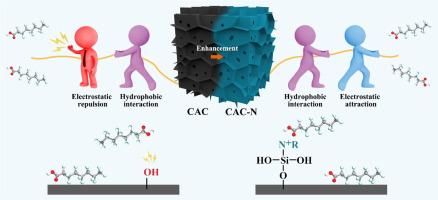从废软木中提取的高效吸附全氟/多氟烷基物质的季铵化分级多孔活性炭
IF 10.9
1区 环境科学与生态学
Q1 ENGINEERING, ENVIRONMENTAL
引用次数: 0
摘要
回收废弃生物质资源转化为活性炭用于污染物捕获是促进可持续发展的关键战略。在此,我们从废软木中开发了一种具有分层孔结构和正电位表面的新型季铵化活性炭(CACN)。CACN对全氟辛酸(PFOA)具有超高的吸附量(qm = 828.74 mg/g)和快速的吸附动力学(k2 = 740.79 g/mg·min),是先前报道的吸附剂的2-20倍。值得注意的是,在环境相关浓度(500 ng/L)下,CACN对PFOA的去除率达到99.7%,将残留浓度降至1.5 ng/L,符合美国环保署2024年对饮用水中PFOA的强制执行限值。实验表征和理论计算表明,静电吸引和疏水相互作用是CACN吸附PFOA的主要动力,而孔隙大小对吸附过程有显著影响。本研究提出了一种高价值利用废软木和有效去除水中PFAS的创新策略。本文章由计算机程序翻译,如有差异,请以英文原文为准。

Quaternized hierarchical porous activated carbon derived from waste cork for efficient adsorption of per-/polyfluoroalkyl substances
Recycling waste biomass resources for conversion to activated carbon toward pollutant capture represents a pivotal strategy in advancing sustainable development. Herein, we develop a novel quaternized activated carbon (CAC![]() N) with hierarchical pore structure and positive potential surface from waste cork. CAC
N) with hierarchical pore structure and positive potential surface from waste cork. CAC![]() N exhibits ultra-high adsorption capacity (qm = 828.74 mg/g) and rapid adsorption kinetics (k2 = 740.79 g/mg·min) for perfluorooctanoic acid (PFOA), outperforming previously reported adsorbents by 2–20 times. Notably, CAC
N exhibits ultra-high adsorption capacity (qm = 828.74 mg/g) and rapid adsorption kinetics (k2 = 740.79 g/mg·min) for perfluorooctanoic acid (PFOA), outperforming previously reported adsorbents by 2–20 times. Notably, CAC![]() N achieved a 99.7 % removal rate of PFOA at an environmentally relevant concentration (500 ng/L), reducing the residual concentration to 1.5 ng/L, meeting the U.S. EPA's 2024 enforceable limits for PFOA in drinking water. Experimental characterizations and theoretical calculations reveal that electrostatic attraction and hydrophobic interaction are the primary forces driving PFOA adsorption by CAC
N achieved a 99.7 % removal rate of PFOA at an environmentally relevant concentration (500 ng/L), reducing the residual concentration to 1.5 ng/L, meeting the U.S. EPA's 2024 enforceable limits for PFOA in drinking water. Experimental characterizations and theoretical calculations reveal that electrostatic attraction and hydrophobic interaction are the primary forces driving PFOA adsorption by CAC![]() N, and pore size significantly influences the adsorption process. This study presents an innovative strategy for the high-value utilization of waste cork and the effective removal of PFAS from water.
N, and pore size significantly influences the adsorption process. This study presents an innovative strategy for the high-value utilization of waste cork and the effective removal of PFAS from water.
求助全文
通过发布文献求助,成功后即可免费获取论文全文。
去求助
来源期刊

Resources Conservation and Recycling
环境科学-工程:环境
CiteScore
22.90
自引率
6.10%
发文量
625
审稿时长
23 days
期刊介绍:
The journal Resources, Conservation & Recycling welcomes contributions from research, which consider sustainable management and conservation of resources. The journal prioritizes understanding the transformation processes crucial for transitioning toward more sustainable production and consumption systems. It highlights technological, economic, institutional, and policy aspects related to specific resource management practices such as conservation, recycling, and resource substitution, as well as broader strategies like improving resource productivity and restructuring production and consumption patterns.
Contributions may address regional, national, or international scales and can range from individual resources or technologies to entire sectors or systems. Authors are encouraged to explore scientific and methodological issues alongside practical, environmental, and economic implications. However, manuscripts focusing solely on laboratory experiments without discussing their broader implications will not be considered for publication in the journal.
 求助内容:
求助内容: 应助结果提醒方式:
应助结果提醒方式:


